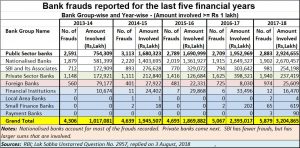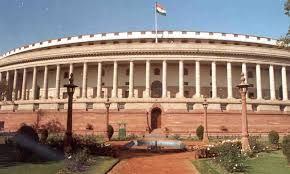http://www.freepressjournal.in/analysis/banker-scamster-and-hidden-hand-make-merry-r-n-bhaskar/1345574
Protecting the banker — and the invisible hand
There is a sense of disquiet among India’s policy-watchers. Such anxieties were confirmed when they saw the data presented before the Lok Sabha on 3 August 2018 (see chart).
 The government pointed out that in 2017-18 alone, there were 5,897 instances of bank-fraud that had come to light and were being investigated. Together, they involve a sum of Rs.32,048.65 crore. As can be seen, the number of instances of frauds and the amounts involved have kept on increasing.
The government pointed out that in 2017-18 alone, there were 5,897 instances of bank-fraud that had come to light and were being investigated. Together, they involve a sum of Rs.32,048.65 crore. As can be seen, the number of instances of frauds and the amounts involved have kept on increasing.
Collectively, the five years represent a total of 24,584 cases of fraud, involving a mind-boggling sum of Rs.1.04 lakh crore. These amounts should not be confused with the NPAs reported by the banks. These were amounts that banks lost through fraud, not bad loans.
The evidence that the government placed before the Lok Sabha on 3 August 2018, highlights how dangerous the July 2018 amendments to the Prevention of Corruption Act could be (http://www.asiaconverge.com/2018/08/india-passes-the-promotion-of-corruption-act/). The protection extended to bankers could cause the the incidence of fraud to further increase.
The government in its reply before the Lok Sabha stated that the “Reserve Bank of India( RBI) has constituted a Committee under the chairmanship of Shri Y H Malegam on February 20, 2018, to, inter-alia, look into factors leading to an increasing incidence of frauds in banks and the measures (including IT interventions) needed to curb and prevent it; and the role and effectiveness of various types of audits conducted in banks in mitigating the incidence of such divergence and frauds.”
The government also stated that the “Central Vigilance Commission, CVC has analysed 17 large value accounts, belonging to seven different sectors namely Gem & Jewellery, manufacturing/Industry, Agro, Media, Aviation, Service/Projects and Discounting of Cheques. It stated that PSBs have been advised to put in place suitable safeguards to protect their organisation’s interests while transacting with these sectors.”
It also stated that the Central Bureau of Investigation (CBI) is investigating 292 bank cheating/ fraud/etc. scam cases as on 27.03.2018. It is worth noting that the investigation relates to just 298 out of 5,879 incidents during that year (or 24,584 during the past five years).
The government reminded the Lok Sabha members that — in May, 2015 — it had issued instructions to all the CMDs/MD & CEOs of PSBs on “Framework for timely detection, reporting, investigation etc. relating to large value bank frauds”, which, inter-alia provides that all accounts exceeding Rs. 50 crore, if classified as Non-Performing Assets, should be examined by banks from the angle of possible fraud. A report would be placed before the Bank’s Committee for review of NPAs on the findings of this investigation. The above instructions have been reiterated in February, 2018. Once again, it is worth noting that despite such instructions, the incidence of frauds did not decline.
And why not? It is worth recalling that when the Rs.5,000 crore NSEL scam came to light, the Ministry of Corporate Affairs lost no time in calling Jignesh Shah a person “not fit and proper” to be on the board of any company. Yet, zoom forward to 2018. Today, the government refuses to do this with Chanda Kochar and her relatives.
Ironically, the government has even allowed Kochar to to apply for reappointment as a director on ICICI Securities. There are other anomalies as well. The Jignesh Shah investigations were completed in record time. The ICICI investigations are now slated to take at least two months more. And this when the NSEL scam did not involve a parallel investigation by the SEC of the USA.
But then the nexus between the government and bank scams is legendary. Remember, that whenever a large scam takes place, there is always a banker, the scamster and the hidden hand (invariably a top ranking bureaucrat, or a politician, or both). This was evident in the Haridas Mundhra Scam (http://www.asiaconverge.com/2018/08/amendments-to-prevention-of-corruption-act-protect-corruption/).
It was evident in the Mallya and Nirav Modi scams too (http://www.asiaconverge.com/2017/09/off-the-book-epayments-have-the-potential-of-big-scams/). Ditto with the Hashad Mehta stockmarket and SGL scam of the 1990s (hhttp://www.asiaconverge.com/2017/09/off-the-book-epayments-have-the-potential-of-big-scams/).
Even earlier, the Rustom Sohrab Nagarwala case of 1971 (https://en.wikipedia.org/wiki/1971_Nagarwala_scandal) confirmed that the unholy nexus of banker, scamster and the hidden hand is always at work in any big financial fraud.
The government’s response is bizarre. It first passes a law stating that legislators and bureaucrats cannot be investigated without prior permission from the higher-ups. Then – on July 23, 2018 — it passes amendments to the Prevention of Corruption Act which extends this protection to bankers as well.
It also protects bribe-takers and threatens to put behind bars any bribe-giver who wants to lodge a complaint, even if the case is one of extortion.
And then the government says that it has zero tolerance for corruption.



































COMMENTS